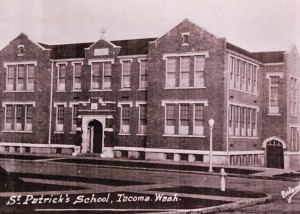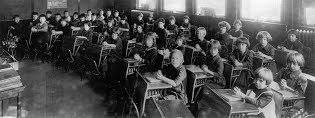History
Parish History
In the 1890 Census, Tacoma had a population of 36,000. History books called it the “city of destiny,” the economy was booming. In 1891, after several years of “boom,” the economy slowed.
There were three Catholic churches in Tacoma at the time: St. Leo’s, the oldest, was located at South D and 11th Street; Holy Rosary, at its present location; and St. Mary’s, at South Yakima near 23rd Street. The churches were under the leadership of the Most Reverend Aegedius Junger, Bishop of the Archdiocese of Nisqually.
Because of the proximity of the three churches and the recognized need for a church in Old Town, the Bishop was permitted to dissolve St. Mary’s and establish Saint Patrick Catholic Church in the Old Town section of Tacoma.
The announcement was made at an early Mass on Christmas Day at St. Mary’s that the next Mass would be celebrated at the newly established Church of Saint Patrick. The first Mass was celebrated on December 25, 1891, in a two-story building owned by Campbell and Powell attorneys at Starr Street and Tacoma Avenue.
1892 – New Church Building is Completed
In the spring of 1892, a small 30′ by 40′ frame church was built on the corner of Tacoma Avenue and Starr Street on property leased from the Tacoma Land Company. The monthly rent was $10. The building was constructed with lumber donated from the Old Tacoma Mill and volunteer labor directed by Messrs, Harrington, and Smith.
The newly completed church received a statue of St. Patrick from the Timothy Murphy family. This statue and the statue of St. Anthony were blessed in the church on March 17, 1892. The small church had a main and small side altar of our Blessed Lady. The twelve pews provided more than adequate seating for the fewer than fifty parishioners; six were men. Miss Josie Mahoney, later known as Mrs. J. C. Murphy, served as the church’s first organist and choir director.
The modest wooden building also served as the first parish school in September 1893. The Pastor, Margaret Casey, and Josie Mahoney were the teachers.
At this time, The Ladies Altar Society was established. The men formed the Elmira Club to secure funds to maintain the church. The League of the Sacred Heart was also established for the spiritual advancement of the parishioners.
1893 – The new Church Building Physically Moves
In May of 1893, the economy that had been slowing came to a stop. It was called the “crash” or “panic” of 1893. Many businesses closed; many people removed their savings from the banks before they closed. The general population, unable to find work or food, lived off the land eating berries and clams! There was no state or local aid available for such emergencies. People with money began buying one-way tickets East. At this time, the Dominican Sisters arrived in Tacoma to establish a school for the Parish. It was to be the first official parochial school west of the Mississippi River. The Dominican teachers were Mother Thomasina, Mother De Chantel, and Sister Aloysius.
Mrs. Hanna Oldfield provided rooms for the Dominican Sisters in her home at 2714 McCarver Street until they purchased property on the corner of Starr and G Streets for their convent and school. Shortly after their arrival, the church building was physically moved to the Dominican’s newly purchased property after the Old Tacoma Land Company reclaimed the leased property on Starr Street and Tacoma Avenue. During these poor economic times, the Parish, under Father Emonds, provided a “soup house” free of charge for all people in need who came for help.
1899 – The School Moves to the Present Day Site
In 1899, Father Emonds departed for Germany due to his failing health. The Rev. LeBlanc, of All Saints Parish in Puyallup, was appointed Pastor; some of the parishioners who helped in the infancy of St. Patrick Parish were the following: John M.Boyle, John McCann, John Nolan, John Geehan, Pat Finnegan, H. J. Marshall, McNerthney Family, Gus Fufleson, T. Babcock, W. M. Casey, D .D. McDonald, Mrs. George Hill, Mrs. Dennis Coleman, Mrs. L. D. Campbell, Mrs. Anna Oldfield, Mrs. Waldo, Mrs. Donovan.
In May of 1899, the property upon which the church stood at Starr and G Streets was purchased from the Dominicans by the Parish. The Sisters had purchased the Col. Pinkerton property across the street for the future home of Aquinas, the present site of Saint Patrick Catholic School. The cornerstone for the first Aquinas building was laid on June 13, 1899.
1905 – Fire destroys church
On the Feast of the Assumption of our Blessed Lady, August 15, 1905, Saint Patrick Catholic Church was destroyed by fire. At this time, the sidewalks were made of wood, and a discarded cigar was thought to have caused the fire. The Dominicans offered to use the auditorium at Aquinas until a new church could be built.
In the fall of 1905, lots were purchased for the present church at 12th and J Streets. These lots had been the former sites of the Atkins Memorial Church, which had been foreclosed and torn down after the economic crash of 1893.
After purchasing these lots for the new church, Father LeBlanc became seriously ill and resigned. Father Fitzgerald was appointed temporary Pastor.
1906 – Construction Begins in Present Day Location
On January 15, 1906, Rev. Joseph F. McGrath became Pastor. He quickly began the construction of the new church, following approval by the 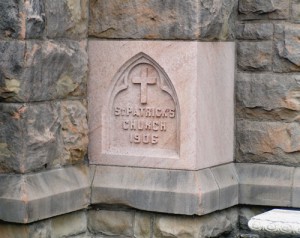 Bishop, Most Rev. E. J. O’Dea. Frederick Heath was the architect, and P. A. Baillargeon was the builder. On March 17, 1906, Bishop O’Dea laid the cornerstone at the feast of Saint Patrick.
Bishop, Most Rev. E. J. O’Dea. Frederick Heath was the architect, and P. A. Baillargeon was the builder. On March 17, 1906, Bishop O’Dea laid the cornerstone at the feast of Saint Patrick.
On December 25, 1906, Christmas Masses were celebrated in the basement of the new building, which was still being constructed.
1907 – Completed and Dedicated
The new church was completed on June 17, 1907. Bishop O’Dea dedicated it on June 30, 1907.
1908 – Old Rectory Sold
In 1908, Saint Patrick Catholic Church purchased the McDaniel family home and property to serve as the Parish Rectory. The old rectory on the corner of Starr and G Streets was sold to the Dominican Sisters, who converted the building into a school for boys known as St. Edward’s Hall.
1915 – Holy Cross parish is Established
In January 1915, the Bishop divided St. Patrick into two parishes due to the tremendous growth. The new Parish of Holy Cross was created, and the Rev. Milinar was named its first Pastor.
1918 – New Bishop
On December 25, 1918, Father McGrath was chosen as the new Bishop of Baker City, Oregon.
1919 – New School Building Ready
Father McGrath celebrated his first Pontifical High Mass in St. Patrick Church on March 30, 1919.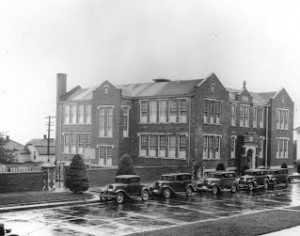
On April 4, 1919, Rev. W. J. Noonan, the Pastor of the Cathedral in Seattle, was appointed Pastor of St. Patrick Parish. It was under the direction of Father Noonan that Saint Patrick Catholic School, on the corner of 11th and J Streets, was completed. Its construction had been postponed due to the First World War.
On October 12, 1919, the North 11th and J Street school buildings were blessed and ready for occupancy. Many dignitaries were present; they included Bishop O’Dea and the Mayor of Tacoma, Mr. C. Ridell.
The school remained in this location for 55 years.
1920 – Parish School Grows
Saint Patrick Catholic School accommodated 325 children at the time. Beginning in July of 1920 and continuing for many years, the Parish purchased properties adjoining the school and church to increase and improve the two playgrounds for the increasing number of children in the school.
Also, an ornamental iron fence was erected between the church and the school during this time. Improvements were also made to the interior and exterior of the church; this included the completion of the church basement, including a sodality room, an auditorium with a stage, and a kitchen. The Parish and the school widely used this area.
1921 – Parish Fair
The Parish Fair was held annually from 1921 to 1941. The Fairs brought in large sums to help reduce the Parish debt.
1924 – Public School Requirement Defeated
A State Initiative that required all children to attend public school was defeated in the election of 1924. The initiative, funded by the Ku Klux Klan, read “that it be a misdemeanor each day a child attended a parochial school.” Members of St. Patrick Parish and prominent citizens from Tacoma to Seattle worked together to defeat this initiative.
1925 to 1926 – Pastor Appointed Domestic Prelate
On November 25, 1925, Pius XI appointed Rev. Noonan Domestic Prelate. His Solemn Pontifical Mass was celebrated on January 25, 1926, in St. James Cathedral, with Bishop O’Dea presiding. A reception was held at St. Patrick Church on the evening of the Investiture Ceremony. At the reception, the children of Saint Patrick Catholic School presented him with a Gladstone traveling bag to carry his robes of office.
1928 to 1929 – Church and Rectory Renovated
The Parish rectory underwent a complete renovation in 1928. The interior was gutted to modernize the building entirely. It accommodated the Pastor, his two associates, and visiting priests. The original wooden altars of the church were replaced with imported marble altars.
June 21, 1929, Rev. Noonan celebrated his Silver Jubilee with Bishop O’Dea presiding. The Most Rev. Joseph McGrath was also present. A banquet for 150 bishops and clergy followed the solemn High Mass.
1932 to 1933- Bishop O’Dea Passes Away
Following the death of Bishop O’Dea on December 25, 1932, the Right Rev. Monsignor Noonan was appointed Administrator and Economus of the Diocese, pending the appointment of a new bishop by the Holy See. Rev. Ailbe McGrath was appointed interim Administrator of St. Patrick Parish during Monsignor Noonan’s absence. He remained in Seattle until the Most Rev. Gerald Toughness was appointed Bishop of Seattle on July 31, 1933.
1940 – New Convent for the Dominican Sisters
In April 1940, St. Patrick Parish purchased the home of the E. R. Gardner family to use as a convent for the Dominican Sisters teaching at the grade school. A convent chapel and a rectory were built on the property the following year.
In the same year, a Manual Arts Building was erected, and Sister Alma was certified by the State of Washington to teach the boys Manual Arts and the girls Domestic Science.
1942 – Parishioners Active in War-Related Projects
After World War II began, St. Patrick Church no longer held Parish Fairs to raise money. In September 1942, subscriptions replaced the Parish Fairs due to the war’s uncertain conditions. It became the responsibility of the Holy Name Society to organize subscription drives to support the maintenance of the church.
During this time, members of St. Patrick Parish were very active in war-related projects. They volunteered many hours of service with the American Red Cross and St. Joseph Hospital, preparing dressings and bandages and working as aides. They also provided for the religious and social needs of the soldiers at Fort Lewis. The Knights of Columbus assisted them in these efforts.
1953 – St. Charles Borromeo is Formed
Following the death of Rt. Rev. Msgr. Noonan, on May 1, 1953, the Rev. Edward J. McFadden was appointed Pastor on July 1, 1953. Soon after his arrival, the Mothers’ Club of Saint Patrick Catholic School was established. In 1956, St. Charles Borromeo Parish was formed to serve the western portion of the St. Patrick Church boundary.
1957 – Aquinas Opens
On September 11, 1957, a new Aquinas Academy for Girls opened for classes. Archbishop Thomas A. Connolly dedicated the building the following month. St. Patrick Parish has assumed financial responsibility for the newly erected building from the Dominican Sisters. This was a period of consistent growth. In the fall of 1974, Aquinas and two other Tacoma Catholic schools — St. Leo and Bellarmine — consolidated to form one high school — Bellarmine Preparatory School.
The 1960s – Vatican II Council Changes Made
A major redecoration of the church’s interior was begun in 1961. The interior of the church was severely damaged by the earthquake in 1965.
The Rt. Rev. Edward J. McFadden was appointed Domestic Prelate in 1963. His death occurred the following year, on May 15, 1964, during heart surgery. Rev. Patrick Clark had served as interim Pastor. His successor, Rev. Thomas J. Pitsch, was appointed Pastor on October 15, 1964.
The sixties were many changes in the church and the nation. The Vatican II Councils were held in Rome, followed by many liturgical changes and a new spirit of ecumenism. Some significant changes were the altar now facing the congregation, Masses in English, Folk Masses, and Home Masses. It was also the time of civil rights marches calling for an end to prejudice, discrimination, and segregation. The Parish, led by Archbishop Connolly and Father Pitsch, was active in all these changes. It was also a period of growth for Saint Patrick Catholic School; its population increased to 650 children.
The Very Rev. Thomas Joseph Pitsch celebrated the Silver Jubilee of his ordination at a reception given in his honor on May 20, 1966. The parishioners gifted him with a trip to the Holy Land.
The new convent was built for the Dominican Sisters teaching at Saint Patrick Catholic School and was ready for occupancy on September 24, 1967. At this time, a two-year period of habit experimentation began for the Sisters. Their options were to maintain the habit, modify it, or discard it for contemporary clothes.
The 1970s – Church is Restored for the 75th Jubilee
Father Pitsch received the Tacoma Human Relations Commission Award from the City of Tacoma on January 22, 1970. He had served as President of the commission the previous year.
On October 22, 1971, Father Pitsch was appointed Pastor of St. John Church in Seattle. That same day, Rev. Joseph M. Marquart was appointed St. Patrick Church’s new Pastor. The consolidation of Aquinas with St. Leo and Bellarmine schools occurred in the fall of 1974 to form one high school, the current Bellarmine Preparatory School. With the former Aquinas Academy building vacant, Saint Patrick Catholic School moved down the hill to occupy it.
During the 1970s, the interior of the church was restored and redecorated, the altar was moved forward toward the congregation, the basement reception area and kitchen improved, and a new addition with an elevator was added. This was done in preparation for the 75th Jubilee of St. Patrick Church in June 1982.
The 1980s – Renew Program Encourages Lay Leadership
On June 2, 1985, Rev. Michael Schmitt replaced Rev. Joseph Marquart. Shortly after his arrival, an Archdiocesan program called Renew was successfully instituted at St. Patrick Church. Renew, a spiritual enrichment program encouraged parishioners to take a more active leadership role in parish life. This was particularly important because of the rapidly declining number of parish priests.
Father Schmitt’ died on November 10, 1987, in a car accident en route to a day hike in the mountains.
Several interim priests were assigned until Father Tony Bawyn was appointed Pastor on April 10, 1988. After only two years as leader of the Parish, he was sent to a Canon Law studies program at Louvain University in Belgium.
The early 1990s – New Rectory for Parish Priest
In July of 1990, the Rev. Michael O’Neil became the 10th Pastor of St. Patrick Parish. He was a recently retired Navy Chaplain, having served for 25 years.
The old Saint Patrick Catholic School on “J” Street was demolished in 1992, and the lot was left vacant until it was decided to purpose the property into a grotto area and a rectory for the parish priest.
1995 to 2015 – Father Seamus Serves as Pastor
1995, Father Seamus Laverty became the 11th Pastor to serve St. Patrick Catholic Church. 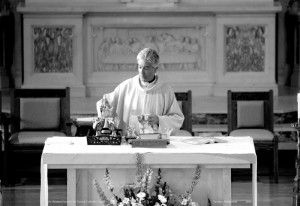
Father Seamus Laverty was the beloved Pastor at Saint Patrick Catholic Church for 20 years— serving the pastoral and sacramental needs of the community until his retirement on June 30, 2015, at the tender age of 70.
In his 20 years as Pastor, Father Seamus baptized 1,240 children, offered 1,148 First Holy Communions, led 840 Confirmations, presided over 378 weddings, performed 648 funerals, and celebrated countless Masses.
2015 to 2018 – A Team of Parish Priests and a Pastoral Coordinator Serve the Parish
On May 16, 2016, the letter from Archbishop Peter J. Sartain was read during Mass, announcing that the sacramental needs of the Parish would be handled by the Jesuit community living in Orton Hall at Bellarmine Preparatory School in Tacoma, with the gracious approval of the Oregon Provincial, Father Scott Santarosa.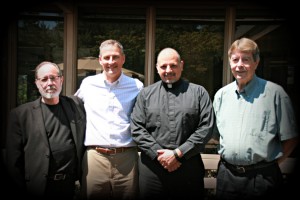
Under the guidance of Father Tom Lamanna, the superior of the Oregon Provincial, along with Faher John Fuchs, a very familiar face at the Parish, and Father Jerry Graham. The team was charged with caring for the sacramental needs at Mass, Reconciliation, Anointing of the Sick, Weddings, and Funerals.
Kevin Lovejoy was appointed the Pastoral Coordinator of the Parish and was responsible for overseeing the pastoral, staff, and financial needs.
Pastor History
July 2018 – Present
A Pastor is Appointed
On May 20, 2018, a letter from Archbishop Peter J. Sartain was read at Mass appointing Father David Mulholland as Pastor of Saint Patrick Catholic Church, Saint Rita of Cascia Catholic Church, and Holy Cross Cross Catholic Church.
Father David, a Tacoma native parishioner at Saint Patrick Catholic Church until he attended Washington State University, celebrated his first Holy Mass of Thanksgiving on June 9, 2002. He returns to his home town-roots and the Parish, where he received all his sacraments.
July 2015 – June 2018
A Team of Parish Priests and a Pastoral Coordinator Serve the Parish
On May 16, 2016, the letter from Archbishop Peter J. Sartain was read during Mass, announcing that the sacramental needs of the Parish would be handled by the Jesuit community living in Orton Hall at Bellarmine Preparatory School in Tacoma, with the gracious approval of the Oregon Provincial, Father Scott Santarosa.
Under the guidance of Father Tom Lamanna, S.J., the Oregon Provincial’s superior, Father John Fuchs, S.J., a very familiar face at the Parish, and Father Jerry Graham. S.J.The team was charged with caring for the sacramental needs at Mass, Reconciliation, Anointing of the Sick, Weddings, and Funerals.
Kevin Lovejoy was appointed the pastoral coordinator of the parish and is responsible for overseeing the parish’s pastoral, staff, and financial needs.
In September 2016, Father Jim Harbaugh, S.J., temporarily joined the team of priests to serve the sacramental needs of the Parish while Father Tom Lamanna, S.J., represented the Oregon Province of the Society of Jesus as the General Congregation 36 in Rome, Italy.
In July 2017, Father Jerry Graham, S.J., was appointed the parish priest serving our faith community with the support of the Jesuit priest.
July 1995 – June 2015
Father Seamus Laverty was the beloved Pastor at Saint Patrick Catholic Church for 20 years— serving the pastoral and sacramental needs of the community until his retirement on June 30, 2015, at the age of 70.
By The Numbers
In his 20 years as Pastor, Father Seamus baptized 1,240 children, offered 1,148 First Holy Communions, led 840 Confirmations, presided over 378 weddings, performed 648 funerals, and celebrated countless Masses.
Now a Senior Priest
Father Seamus— now a Senior Priest, spends time on the golf course — a much-loved pastime when he is not in prayer.
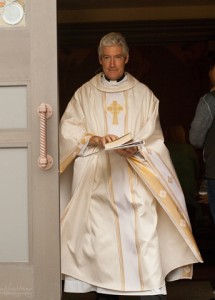
God saved the best for last. Father Seamus Laverty, in reflection on his time at Saint Patrick Catholic Church and School
His Welcome Message is Still Relevant
Although he is no longer the Pastor of Saint Patrick Catholic Church, his welcome message to the faithful who grace the pews for Mass is still poignant and relevant.
Dear friends of Christ in the Saint Patrick Catholic Church Community,
We welcome you into our spiritual family. We are truly blessed by a spiritually active and enthusiastic faith-filled community. As members of the Body of Christ, we take seriously and recognize our call to worship and serve the Lord from whom all good things come.
We hope you will become actively involved in the life of our community by worshipping with us and sharing your God-given gifts with us. Together, through our worship and service, may we grow in appreciation of God’s great love for us all. I sincerely hope you also experience the warmth and hospitality I received when I came here. Again, welcome to our Saint Patrick Catholic Church community.
In Christ,
Father Seamus Laverty
Getting To Know Father Seamus
If you have never met Father Seamus or want to learn more about him, his life, and his service to the Saint Pats community, read the Question & Answer column in The News Tribune, published on July 13, 2015, shortly after his retirement.
The Irish Blessing
Father Seamus has sung the Irish Blessing in prayer over many in the parish community. Parishioners did the same for him at the end of his final Mass as Pastor.
Final Mass
During his final Mass as Pastor— touching moments with parishioners were captured in a snapshot by photographer Julie Ammann, a Saint Pats parishioner who has captured many special events at the Parish.
She took beautiful photos and created a video tribute in honor of Father Seamus’ final Mass as Pastor of Saint Patrick Catholic Church & School. This is one of many tributes honoring Father Seamus’ 20 years as Pastor.
School Tribute
Mary Norton, a young parishioner and student at Saint Patrick Catholic School, read a tribute to Father Seamus’ before his final Mass with the students in early June 2015.
Retirement Party
A few short weeks later, photos collected from parishioners spanning 20 years, compiled into a video slideshow by Shea Cochran, a parishioner and a shutterbug who has photographed many school events, was shared with the guests at Father Seamus’s golf-themed retirement party hosted in the gym at Saint Patrick Catholic School on June 20, 2015.
Father Seamus will always be part of the fiber of Saint Patrick Catholic Church.Saint Patrick Catholic Church & School Logo Symbolism
In 2011, the Saint Patrick Catholic Church & School created one logo to represent the church and the school. Before this, the church and the school each had individual logos. A committee comprised Parish and school staff and a graphic designer who was also a school parent.
The team built the logo using the Celtic cross on the I Street’s corner signage. With a graphic designer’s help, the Celtic cross was replicated and served as the anchor for the rest of the logo.
A logo was created after many design changes, reviews, and input from school and parish groups.
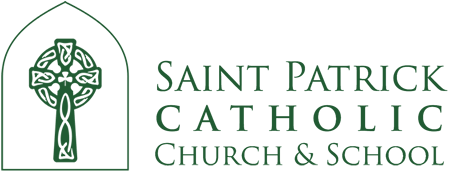
The Symbolism of the Saint Patrick Catholic Church and School Logo
Celtic Cross
- A traditional symbol of Ireland and our patron saint – Saint Patrick
- The current symbol of our Saint Patrick Catholic Parish
- The cross is a reminder that Christ died for us on the cross
- The circle is symbolic of eternity, which emphasizes the everlasting love of Christ
- The shamrock is the current symbolic “mascot” of Saint Patrick Catholic School.
- The shamrock also represents education, as Saint Patrick used the shamrock to teach the Irish the mystery and meaning of the Trinity.
The merger of the Celtic Cross and Shamrock
- Symbolizes the unity between our Parish and our School
- Placed in the center of the Celtic Cross to remind us that our children are the heart and center of our community and will eventually become our Parish
- A strong yet calming one of Ireland’s 40 shades of green.
- Symbolic of our home here in the Evergreen State
Arched Border Surrounding the Cross and Shamrock
- Representative of the architectural design that provides the foundational support of our parish worship space
- The arch points upward – the direction our eyes and hearts should always be directed toward God.
- The arch expands beyond the confines of the Celtic cross and shamrock to reflect our Parish and school’s influence beyond our Parish and school community.
- It serves as a reminder of the fish as a symbol of 1st Century Christians
- Represents the origin of our Parish to serve the community of fishermen and families of North Tacoma at the turn of the century
- Reinforces our Catholic heritage
- Informs that Saint Patrick Catholic Church and School is a CATHOLIC community

